Research Results
Fish immune system enhancing substance discovered
The study for aquaculture feed ingredients to replace fish meal FY2018
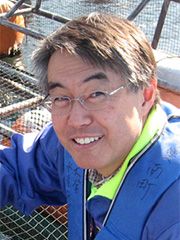
- Takeshi Miura (Professor, Ehime University)
- Adaptable and Seamless Technology Transfer Program through Target-Driven R&D (A-STEP)- entrepreneurial challenge type
- "Creation of an innovative fish-rearing system utilizing houseflies" Research Director (2009-2013)
Resolving aquaculture fish feed issues with insects
Fish meal is a crucial animal protein source in aquaculture fish feed. In recent years, consumption of marine products has increased in emerg- ing markets, particularly in China, and worldwide demand for aquacul- ture has increased dramatically. 20 years ago, fish meal cost approxi- mately 50 yen per kilogram but the price has more than quadrupled in price since then. Since the fish used to make the fish meal (primarily Japanese anchovy) is a natural resource, the cost is unstable and deple- tion through overfishing will have an impact on other marine organisms. There are therefore hopes that feed that avoids the use of fish meal will be developed.
The most important aspect of any potential alternative raw material is secure supply of the necessary amounts at low cost. Professor Takeshi Miura and his team therefore focused their attention on insects as a source of animal protein. Although it is estimated that the biomass of insects is more than 15 times larger than that of humans, they are hardly utilized at all as a protein source. The proactive use of insects as a protein source served as a starting point for the research. It would be impossible to provide a stable year-round large-scale supply of insects of a single type by harvesting insects from natural environments. Silkworms, crickets, and a type of housefly were selected as candidates because their propagation can be artificially controlled and because of their promise as potential protein sources.
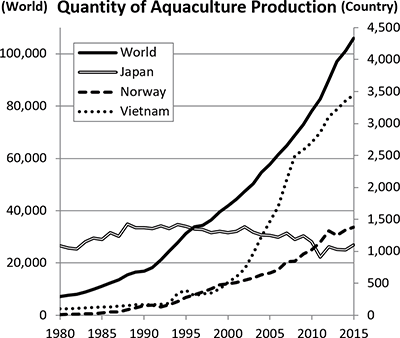
Aquaculture production output worldwide and in Japan, Norway, and Vietnam
(Based on FAO data)
Insect meal promote fish growth and improve fish health
The insect that Professor Miura and his team focused on was the housefly. Although houseflies have a negative image in terms of hygiene, they also have a considerable number of advantages including the fact that -they breed rapidly, their growth can be controlled artificially, housefly larvae can feed on livestock manure, and their own manure can also be used to create high-quality fertilizer. It would be no exaggeration to say that this represents an outstanding recycling system in which useful resources can be produced from human-originated waste. The team's latest achievement was the successful switching of the feed of a group of aquaculture fish from fish meal entirely to housefly meal. This approach provides a stable supply of protein for aquaculture while also helping to preserve natural resources.
Professor Miura and his team began testing the efficacy of mixing housefly pupae into fish meal. They found that the feeding response of the aquaculture fish was extremely good and that the fish tended to grow longer and heavier than those fed on fish meal only. The team identified the following three beneficial effects: 1. The fish prefer the feed; 2. Their coloration becomes more vivid; and 3. Their immune systems become more active, strengthening their protection against disease. When the team carried out induced infection experiments on red seabream, those that were given feed that did not include housefly pupae all died by the 12th day after infection while none of those that were given feed that did include housefly pupae died during the course of the 15-day experiment. Such a clear boost in disease resistance was unexpected. Professor Miura and his team subsequently carried out R&D work on identifying the substances behind the immune system enhancement and the mecha- nisms by which the substances achieve this.
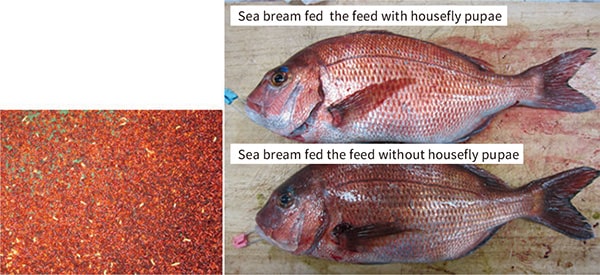
Housefly pupae (left). Feed that includes housefly pupae outperformed feed without housefly pupae both in terms of growth performance and coloration (right).
Insect-based feed can prevent fish disease in cultured fish
Knowing that houseflies have some kind of substance in them that stimulates the immune systems of fish, Professor Miura and his team investigated the effects on fish immune systems of 13 different kinds of insect including houseflies. They found that many of the insects worked to enhance the immune systems of fish. Melon fly and Japanese oak silk moth were found to be the most effective of the 13 insects, and from their pupae the team managed to isolate the immune system-enhanc- ing substances. Analysis of these isolated substances showed that in both cases they were as yet undiscovered bioactive polysaccharides. The substance isolated from melon flies was named dipterose and the substance isolated from Japanese oak silk moths was named Silkrose®.
For dipterose and Silkrose® to be utilized at aquaculture facilities, there needs to be a plentiful and inexpensive supply. Therefore instead of melon flies and Japanese oak silk moths, which can only be produced in small amounts, the team shifted their focus to silkworms which contain similar levels of Silkrose® to Japanese oak silk moths. Although domestic production of silkworm pupae is small in scale, they are produced in huge quantities in China as a byproduct of silk production. The team therefore worked on a variety of different tests aimed at com- moditization of silkworm pupae as a source of Silkrose®.
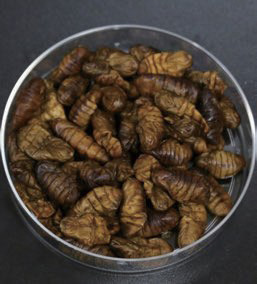
Silkrose®, a new substance that can be used to enhance the immune systems of fish, was discovered in silkworm pupae
Commercialization of Silkrose®
Induced bacteria and virus infection experiments on yellowtails and red sea bream given feed containing Silkrose® (0.1%) showed clear improve- ments in disease resistance. There were also clear-cut improvements relating to growth, skin immune response, stress reduction, meat quality, and so on. Since these R&D findings could help solve aquaculture issues and contribute to further development of the field, members of the team involved in the research provided funding for its commercialization, and in 2012 they established a startup called Ainan Liberacio Co., Ltd. to create new aquaculture systems based on the utilization of insects.
Silkrose® was test marketed from F 2017, and the company is also working on developing technologies required to cheaply mass produece insect meal to provide an alternative raw material to fish meal.
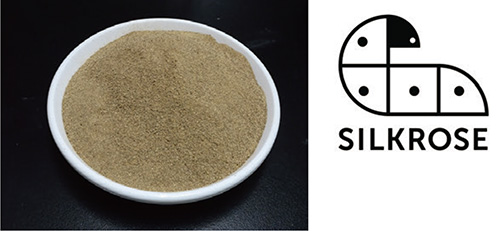
Silkrose®, test marketing of which is now underway
